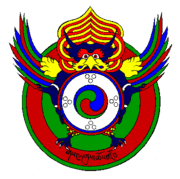Aro gTér
 | |
| Formation | 1980s |
|---|---|
| Founder | Ngakpa Chögyam |
| Type |
Tibetan Buddhism Western Buddhism Dzogchen |
| Headquarters |
Vale of Glamorgan, Wales, United Kingdom |
| Website |
arobuddhism |
The Aro gTér is a lineage within the Nyingma school of Tibetan Buddhism. The pure vision terma on which it is based teaches all Buddhist topics from the point of view of Dzogchen. The Aro gTer terma was received by Western-born Buddhist, Ngakpa Chögyam. The lineage is a ngagpa or non-monastic lineage and emphasizes householder practice and non-celibate ordination. All of its contemporary teachers are ethnically non-Tibetan.[1]
History
Ngakpa Chögyam founded the Aro gTér organization in the 1980s.[1] He was born in Hanover, Germany in 1952 and grew up in England. His father was English and his mother German; he is distantly related to the composer Franz Schubert. He studied Buddhism from the early 1970s through 1989, while working as a manual laborer, factory worker, and a truck driver in Britain to subsidize his education.[2]
According to a terma which Ngakpa Chögyam received in visions, the Aro tradition has antecedents in a 'Mother Essence Lineage' of female tertöns originating with Yeshe Tsogyal,[3] and forward to Kyungchen Aro Lingma (1886-1923).[4][1] According to the Aro gTér, Kyunchen Aro Lingma first discovered the terma.[4][1] This terton says Aro Lingma transmitted the lineage to her only son, named Aro Yeshe (1915-1951).
According to Gyaltsen Rinpoche, Dilgo Khyentse Rinpoche recognized Ngakpa Chögyam as Aro Yeshe's tulku,[5] and Khordong gTerchen Tulku Chhi'med Rig'dzin Rinpoche recognized him as 'a-Shul Pema Legdeas', the incarnation of Aro Yeshe's predecessor.[4][5]
In the 1970s, Ngakpa Chögyam studied with Chhi'med Rig'dzin Rinpoche,[1][6] Dudjom Rinpoche,[5] Dilgo Khyentse Rinpoche,[5] Kunzang Dorje Rinpoche,[5] and Khamtrül Yeshé Dorje Rinpoche.[7] He wrote about his experiences in his 2011 book, Wisdom Eccentrics.[8]
H.H. Dudjom Rinpoche gave the name Sang-ngak-chö-dzong to establish the western White Tantric Community organization,[5] which is located in Britain.[3][9]
Teachings and practices
The principal practices are tantra and Dzogchen.[1]
References
- 1 2 3 4 5 6 Cousens 2010, p. 196.
- ↑ "Ngakpa Chögyam Biography". Aro Books Worldwide. Retrieved 3 February 2015.
- 1 2 Chögyam 1994.
- 1 2 3 Rawlinson 1997, pp. 207.
- 1 2 3 4 5 6 Gyaltsen Rinpoche 1995, pp. xi-xvii.
- ↑ Chhi’-mèd Rig’dzin Rinpoche 2003.
- ↑ Ngakchang Yeshe Dorje Rinpoche 1991.
- ↑ Chögyam 2011.
- ↑ Chögyam & Déchen 2003, p. 308.
Sources
- Chhi’-mèd Rig’dzin Rinpoche, Khordong gTérchen Tulku (2003), "Foreword", in Chögyam, Ngakpa; Déchen, Khandro, Spectrum of Ecstasy: The Five Wisdom Emotions According to Vajrayana Buddhism, Shambhala Publications, ISBN 978-1-59030-061-9
- Chögyam, Ngakpa (1994), "The mother essence lineage", Gassho, 1 (5), retrieved 2009-05-18
- Chögyam, Ngakpa (2011), Wisdom Eccentrics, Aro Books, Inc., ISBN 978-0965394864
- Chögyam, Ngakpa; Déchen, Khandro (2003), Spectrum of Ecstasy: The Five Wisdom Emotions According to Vajrayana Buddhism, Shambhala Publications, ISBN 978-1-59030-061-9
- Dorje, Rig'dzin (2001), Dangerous Friend: The Teacher-Student Relationship in Vajrayana Buddhism, Shambhala Publications, ISBN 978-1-57062-857-3
- Cousens, Diana (2010), "Aro gTér", in Melton, J. Gordon; Baumann, Martin, Religions of the World: A Comprehensive Encyclopedia of Beliefs and Practices (2nd ed.), Santa Barbara: ABC-CLIO, p. 196, ISBN 9781598842036
- Ngakchang Yeshe Dorje Rinpoche, The Seventh Khamtrül Lama (1991), "Foreword", in Chögyam, Ngakpa, Rainbow of Liberated Energy: Working With Emotions Through the Colour and Element Symbolism of Tibetan Tantra, Element Books, ISBN 978-0906540923
- Gyaltsen Rinpoche, The Seventh Khamtrül Lama (1991), "Foreword", in Chögyam, Ngakpa, Rainbow of Liberated Energy: Working With Emotions Through the Colour and Element Symbolism of Tibetan Tantra, Element Books, ISBN 978-0906540923
- Rawlinson, Andrew (1997), The book of enlightened masters : Western teachers in Eastern traditions (first print ed.), Chicago, Ill. [u.a.]: Open Court, ISBN 978-0812693102
- Simmer-Brown, Judith (2001), Dakini's warm breath: the feminine principle in Tibetan Buddhism (1st ed.), Boston: Shambhala, ISBN 1-57062-720-7
Further reading
- Ngakpa Chogyam Rinpoche (May–June 1994). "Sang-ngak-cho-dzong and the Evolution of the Apprentice Programme" (PDF). Gassho. 1 (4). Retrieved 2015-06-16.
External links
- Official website
- Aro encyclopedia
- Approaching the Aro gTér: a member's "experience with an unusual Tibetan Buddhist lineage"